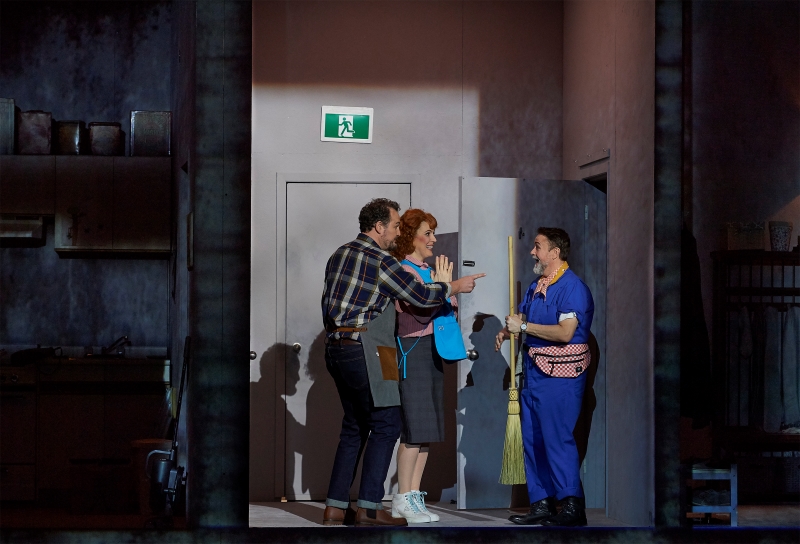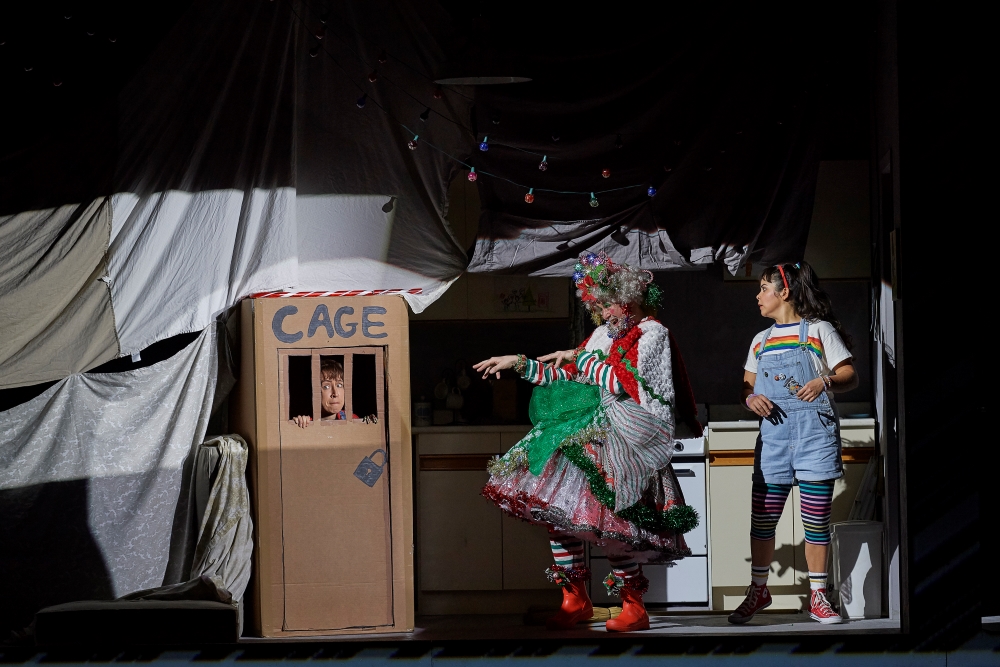Far too many recent adaptations of Brothers Grimm fairy tales adhere to the belief that the ideal presentation of a children’s story emphasizes adult themes and dark undertones—but Canadian Opera Company’s new production of Engelbert Humperdinck’s Hansel & Gretel (seen Feb. 6th), presented in partnership with Banff Centre for Arts and Creativity, proves that an innovative staging of a classic can be best informed by an innocent, child-like mindset.
Director Joel Ivany’s vision of Hansel & Gretel, set in a modern-day Toronto apartment complex, maintains the family-friendly spirit of Humperdinck’s original adaptation of the fairy tale, without compromising artistic complexity. Ivany negotiates the differing realities of children and adults, creating striking duality within one space. As in the original tale, Hansel and Gretel live in poverty. By setting the scene in a humbly furnished apartment complex with graying walls, Ivany’s direction illustrates a contemporary struggle facing many Canadian families. With housing costs in the GTA at an all time high, coming home to an empty refrigerator is not uncommon. When left to their own devices, the brother and sister cope with hunger by distracting each other. Mezzo-soprano Emily Fons—who played Hansel last April with the Michigan Opera—embodies the trouser role with a mischievous charm, matching the energy with which she sings the nonsensical syllables in “Brüderlein, komm tanz mit mir” with the comedic addition of viral dances like dabbing and flossing. The duet quickly unravels into a chaotic scene as she and Gretel (soprano Simone Osborne) break into a round, which increases in volume and energy with every repetition, culminating in the two creating a mess in the family kitchen.

Russell Braun (Peter) Krisztina Szabó (Gertrude) and Michael Colvin (the Witch) in Canadian Opera Company’s Hansel and Gretel. Photo: Michael Cooper.
When mezzo-soprano Krisztina Szabó enters, her empathetic portrayal of Gertrude heavily contrasts Hansel and Gretel’s energy. Szabó paints her character as world-weary rather than cruel, for although she threatens to severely punish her children after witnessing their mess, she excuses herself to the hallway, venting the full extent of her frustration, as many parents do when they reach their limit. Her quick vibrato evokes a mournful quality, as witnessed at the climax of “Marsch! Fort in den Wald”, where she kneels on the floor in her cashier’s smock, her sustained high notes convey subtle poignance. In Act I, it’s clear that Hansel and Gretel can escape from their difficult reality in a way their parents cannot. When Gertrude shoos her children out of the house, and they draw up a “survival plan” to guide them on an adventure through the different apartments in their building, they view survival with much more enthusiasm than their doleful mother. As they move through the recognizable plot points of the fairy-tale, they slowly include their adult neighbours in the fun. The Sandman, for example, is an upstairs neighbour who appears unremarkable at the show’s opening. But when he invites Hansel and Gretel inside for snacks, they transform his space into an enchanted forest. The true splendour of the striking set and projection design by S. Katy Tucker becomes apparent when bright green illustrations of trees appear on the graying walls, and their neighbour re-emerges as a magical shimmering Sandman, while all the apartment complexes below remain unchanged. The same elderly neighbour is then dressed in homemade wings made from a storybook and mismatched tutu fabric (beautifully designed by Ming Wong). Soprano Anna-Sophie Neher sings “Der kleine Taumann heiss’ich” with a clear, bell-like quality that implies youth as she is transformed—in the children’s minds—into the beautiful Dew Fairy.

Simone Osborne (Gretel) and Emily Fons (Hansel) in Canadian Opera Company’s Hansel and Gretel. Photo: Michael Cooper.
The Witch in this staging is decidedly unmenacing. Sung by tenor Michael Colvin, the character is a re-imagined version of the apartment’s janitor, cloaked in a costume constructed from old wrapping paper and Christmas decorations. The choice to cast a tenor instead of a mezzo for this role draws attention to the fact that this is an adult man playing make-believe to humour the children, which gives the character unexpected warmth. He adds a subtle nasal quality to his voice to emphasize the deliberate goofiness of his portrayal. Each adult character, in turn, is vibrantly transformed by Hansel and Gretel’s presence in their lives, and when they finally reunite with their parents, their mother’s grim demeanour metamorphoses into pure joy.
By viewing the world around them as something extraordinary, Hansel and Gretel invite the adults in their small community to do the same. Director Joel Ivany’s reputation for giving older repertoire works new relevance for a modern and diverse audience precedes him, creating a show truly designed for all ages. The production includes enough spectacle to engage young children, but can also entice adults into a childlike mindset. By creating clever duality between the imagined and the real, the COC’s Hansel & Gretel reveals the significance of community, the value of reaching out to your neighbours, and how a changed perspective can make magic of the mundane.










